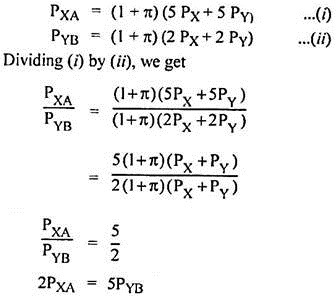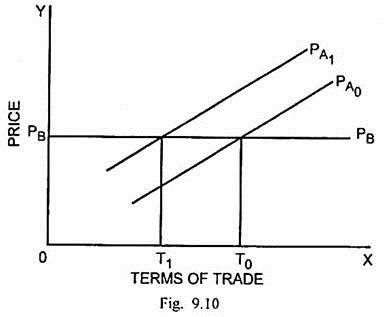In this article we will discuss about the assumptions and criticisms of Emmanuel’s theory of unequal exchange.
There has been a strong opinion among a large group of economists that the international trade has been a source of exploitation of the less developed countries at the hands of advanced countries. Emmanuel attempted to explain the deterioration of terms of trade and consequent exploitation of the less developed country on the basis of unequal international exchange of products between the developed and less developed countries. The basic cause of unequal exchanges between them, other things remaining the same, has been the wide disparities in their wage levels.
In his analysis, Emmanuel has drawn upon the Marxian theory of product pricing which recognises that the workers are paid subsistence wages by the capitalists to generate large surplus value. As there are technological improvements in the developed countries, there is considerable improvement in the productivity per man-hour.
The productivity per man-hour in the less developed countries, on the other hand, is far low because of low technical efficiency. These countries have failed to secure the gains of technical progress. It is on account of technical deficiency that the absolute and relative levels of output in the less developed countries remain low.
ADVERTISEMENTS:
However, the production costs and product prices in these countries remain low because of the low wage levels. It contrast, the wage levels in developed countries being relatively higher, the costs and product prices are high. In order to import high-priced products from the developed countries, the less developed countries have to export large quantities of their low-priced exportable goods. In this way, the unequal exchanges between developed and less developed countries arise on account of disparities in their wage levels.
Assumptions of Emmanuel’s Theory:
Emmanuel’s theory of unequal exchange rests upon the following assumptions:
(i) International exchange takes place between two countries A and B. While country A is a developed country, the country B is less developed.
(ii) The exchange is related to two goods, X and Y.
ADVERTISEMENTS:
(iii) Capital is mobile between the countries.
(iv) Labour is not mobile between the countries.
(v) While wage level is low in the less developed country, it is relatively high in the developed country.
(vi) Product prices are low in less developed country but these are higher in the developed country.
ADVERTISEMENTS:
(vii) The wage levels are independent of product prices.
(viii) The rates of profits are equal in the two countries.
(ix) Each country specialises in the production and exchange of a specific product.
(x) There is free international trade.
(xi) There is an absence of transport costs.
The unequal exchange between A and B and consequent deterioration of terms of trade for the less developed country B may be explained through a hypothetical example. It is supposed that country A specialises in the production of commodity X, whereas B specialises in the production of commodity Y. The people in both the countries consume both the commodities, X and Y.
The wage level in country A is high and it is supposed that people in that country can buy 5 units of X and 5 units of Y, In the low wage country B. people can buy 2 units of X and 2 units of Y. Price in each country is constituted by wage per unit and rate of profit per unit. The rate of profit (π) in both the countries is assumed to be equal. Price of X in country A is denoted by PxA that of Y in country B by PyB.
It shows that country B has to export 5 units of Y in order to import 2 units of X. This signifies that the exchange between the two countries is unequal and the terms of trade are favourable to the developed country A and unfavourable to the less developed country B. It is explained also through Fig. 9.10.
In Fig. 9.10 the terms of trade are measured along the horizontal scale and prices of products in two countries are measured along the vertical scale. Price of product Y of the less developed country B is supposed to be given and it is represented by the horizontal line PBPB. Originally price of commodity X in developed country A is expressed through the curve PA0 and the terms of trade are T0.
As there is an increase in wages and costs in country A, the price of product X increases and higher price of A is expressed through the price curve PA1 and the terms of trade for country B get determined at T1. Thus there is deterioration of terms of trade for the less developed country owing to the unequal exchange between the two countries.
Criticism of Emmanuel’s Theory:
The theory of unequal exchange has been attacked on the following main grounds:
(i) Restraints on Mobility of Capital:
ADVERTISEMENTS:
Emmanuel’s theory assumes that capital is mobile between the different countries. In fact, there are several restraints on free international capital flows such as exchange rates, exchange controls, trade and other economic policies as well as the political policies. Therefore, the unequal exchanges can occur not only because of wage differences but also due to differences in the cost of capital in different countries.
(ii) International Immobility of Labour:
In this theory, the assumption has been taken that there is lack of mobility of labour among the different countries. It is recognised that continued wage differences are essentially because of labour immobility. No doubt, there are serious obstacles in the mobility of labour internationally but it is a fact that there is substantial movement of both skilled and unskilled labour from the less developed to the developed countries.
Although it has led to a small rise in wages in the former, yet there has been no discernible decline in wage levels in the developed countries. The assumption of international immobility of labour taken in this theory is not valid.
ADVERTISEMENTS:
(iii) Exploitation of the Less Developed Countries:
Emmanuel ascribes the exploitation of the poor countries to unequal exchange. Actually the poor countries suffered from the economic exploitation at the hands of the rich countries on account of the historical and several other reasons. Despite their exploitation, the unequal exchange could not obstruct their march towards progress.
(iv) Equality of Rate of Profit:
Emmanuel’s theory assumes the equality of rate of profit in the less developed and developed countries. In fact, the rates of profits are significantly higher in the former due to large size of markets, growth of MNC’s and technical advance. In contrast, low rate of capital formation, technical backwards, small extent of market, economic and rigidities and high degree of risk have kept rates of profits relatively low in the less developed countries. So the assumption of equality of rate of profits in the less developed countries is completely unrealistic.
(v) Too Limited Approach:
Emmanuel has laid too much emphasis in his theory upon the view that unequal exchange between countries stems exclusively from wage differences between the developed and less developed countries. In fact, unequal exchange between the countries results from a multiplicity of economic, social, technical and institutional factors. All those factors responsible for unequal exchange have been ignored by Emmanuel.
ADVERTISEMENTS:
(vi) Restricted Scope:
This theory recognises that the unequal exchange between the developed and less developed countries is the outcome of wage difference between them. The wage differences are very little among the developed countries but still unequal exchanges are found among them. In the same way, the wage levels are generally low in the least developed countries but unequal exchanges are present even among them. Emmanuel greatly restricted the scope of his analysis by holding that unequal exchange exists only among the less developed and developed countries.
(vii) No Free Trade:
Emmanuel assumes that there are no tariff and non-tariff restrictions upon trade. In fact, both developed and less developed countries take resort to trade restrictions. It was not realistic on the part of Emmanuel to overlook the barriers upon trade imposed by the trading countries.
(viii) Transport Cost:
Alike the traditional theorists, Emmanuel too assumes the absence of transport cost. In real life, transport costs are certainly present and they do have considerable effect upon the trade flows among the countries.
ADVERTISEMENTS:
(ix) Limited View of Adverse Terms of Trade:
Emmanuel attributed the adverse terms of trade in the case of less developed countries only to the unequal exchange resulting from wage differential.
However, the writers like Singer, Prebisch and Fleming maintained that historical deterioration of terms of trade of the less developed countries was due to such factors as product improvement in industrial countries, technical progress, surplus production of primary products, low income elasticity of demand, immiserizing growth, impact of imports and foreign investment, growth of synthetic products, regional economic groupings, growth of MNC’s and protectionist policies of developed countries.
It is too myopic to consider wage differences alone as the cause of adverse terms of trade, exploitation and poverty of the less developed world.

